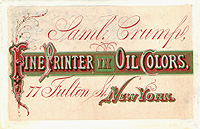|
Trade cards printed on coated stock are a collector's delight. A great part of their appeal comes from their being "early." Nearly all American cards on coated stock were printed in the 1850s and 1860s, well before the heyday of the trade card that commenced with the 1876 Centennial Exhibition, soared through the 1880s and into the 1890s, and concluded by 1900. The cachet that comes from being older than most other trade cards is enhanced by an accompanying degree of rarity. Coated stock is paper that has been coated with a chemical substance to achieve a glossy finish. In the mid-nineteenth century, a variety of materials were used to create the sheen, individually and in combination with others: white lead (highly toxic!), animal hide glue, isinglass (a gelatin derived from the internal membranes of sturgeon and other fish), and kaolin, sometimes referred to as china clay. Once the finish is applied to card stock, transforming it into coated stock, ink placed upon a card's surface remains there, rather than soaking into the paper. This contributes to an enhanced clarity of printed lettering and images. Finer resolution, coupled with a shiny appearance that naturally caught people's eye, enabled coated stock to become the medium of choice for many types of printed output, particularly advertising, soon after its introduction. The process of coating paper stock was developed in England, but was used most extensively in continental Europe, particularly Belgium. The 1840s and 1850s saw the advent of the Belgian "porcelain cards," sumptuously designed and beautifully printed trade cards whose high-gloss finish really did (and often still do) have the look of porcelain. In the United States, coated stock was first used in 1852. Along with most other American commercial printing of the time, coated stock pieces were usually done in black and white, or in just one color. However, advances in color printing technology soon made the use of multiple colors more feasible, and by the mid-1850s, multicolor coated stock trade cards began to appear. Among the finest (and best-known) examples of full-color coated stock trade cards are clipper ship cards. These were cards issued to advertise specific voyages of clipper ships from the east-coast ports of New York and Boston to San Francisco in the years following the discovery of gold in California (although their primary period of distribution, the late 1850s and early 1860s, was well after the peak of Gold Rush fever). Clipper ship cards were the first identifiable genre of American advertising artwork to incorporate significant color. Cameo cards represent another coated stock trade card niche. Virtually all cameo cards, which typically feature a tableau within a cartouche and are generally embossed, were made using coated stock. As coated stock trade cards, broadsides, and other works of what we now call ephemera were produced by printers, it is only natural that some printers used coated stock in creating their own advertisements. Coated stock trade cards were issued for other printing-related products, too, such as ink, type, and powders for bronzing. Coated stock trade cards were distributed to advertise many, many other American products, from pianos to steamships. The use of coated stock began to fade in the late 1860s, primarily because advances in all areas of chromolithography (machinery, ink, production processes) allowed progressively better print quality without the need for specialized (and more expensive) paper stock. Except for an occasional piece, production of coated stock cards ceased well before the national craze of pasting advertising cards into albums commenced, and thus are found only infrequently today. It's not unusual to find a coated stock trade card whose finish has become at least somewhat oxidized. This is characterized by a darkening of the surface, usually beginning around the edges. This can be cleaned by gently applying a solution of hydrogen peroxide and water. Warning: this is not for the faint of heart! If you do come across a coated stock trade card in an album, do not try soaking it out. Complete immersion into your bathroom sink can have nasty repercussions for the entire card, and particularly for the coated stock finish. Carefully remove the card from the album page, leaving as much album paper stuck to the back of the card as wants to remain. If you're like your author and can't stand the thought of unwanted album page fragments plastered on the reverse of your new treasure, consult an art conservationist to finish the job!
|
